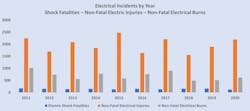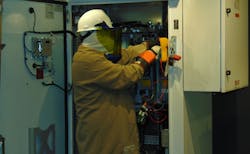An Electrical Accident Waiting to Happen
Electrical safety requirements, personal protective equipment (PPE), and safety by design have grown astronomically over the past 25 years. OSHA’s rules for electrical safety date back almost 50 years. NFPA 70E, Standard for Electrical Safety in the Workplace, was first published in 1979 and continues to address improvements in technology and safe work practices. The current edition of NFPA 70E provides in-depth information on electrical safety program requirements and responsibilities, defines qualified persons, gives eight steps for creating an electrically safe work condition, details the process of electrical hazard analysis, and gives the rules for establishing protective boundaries and selection/use of electrical PPE. Yet, statistics over the past 10 years do not show significant declines in electrical fatalities and injuries. There were 126 electrical fatalities in 2020 (the most recent data available). There were an additional 2,220 non-fatal electrical injuries resulting in missed days from work and 620 electrical burn injuries (Fig. 1).
Role of human behavior
We typically base decisions on past experiences. If we have not been injured performing a certain task, there is little or no reason to believe we will be injured the next time around. However, circumstances change. Incidents tend to occur because of variables coming together at once. The Domino effect does happen — an injury or even a fatality occurs as the result of a series of unsafe conditions or acts (Photo 2).
An example of such a series of conditions caused fourth-degree burns and potential amputation to a trained and qualified electrical worker’s left hand while he was performing routine testing and troubleshooting of a 75VDC safety circuit.
- The worker had performed the task hundreds of times with no injuries or near misses.
- The test equipment to be used was faulty; the 75V power lead to the test set was not properly shrouded where it connected to the test set, and a frayed copper wire protruded from the shroud.
- While adjusting the test unit, the worker’s ring finger (on his left hand) came in contact with the frayed copper strand. The initial shock caused an involuntary contraction of the muscles in the left hand, and the hand/arm was drawn tightly to the worker’s chest. Smoke was pouring from the worker’s hand. Attempts to push the hand away from the chest and pull the fingers open were impossible as the strength of the constricted muscles could not be overcome with the free right hand. Shortly, the worker was able to pull the power lead from his contracted hand with his free right hand.
- Pulling his fingers open on his left hand, the worker found exposed and burnt tissue and bone — a fourth-degree burn. The worker went into physical shock due to the trauma and immense pain.
- Disregarding the available radio on his belt, the worker hid his injury from fellow workers by holding a sweatshirt wrapped around his injured hand and drove himself to a nearby hospital. The worker walked into the emergency and collapsed.
- Preparations were made to amputate the hand the next day. Fortunately, blood flow returned to the hand, and the worker’s hand was saved. A considerable lost time accident resulted.
Why would a worker risk using a faulty test set only to suffer a painful and debilitating injury, which was clearly a violation of NFPA 70E? An Informative Annex in 70E provides insight and can help recognize conditions to prevent such incidents. Here are contributing factors identified in the company’s original incident report (could it be a domino effect?):
- Electricians were working seven days per week, 12 hours per day to meet production demands.
- The work was outdoors in hot, humid conditions.
- The test set had been identified as faulty, but the safety culture was “just be careful as a newer model is on order.”
- There was no written procedure for the task.
- The worker had just been told he may be “bumped” to another location in a different state. The worker had recently purchased a home for his young family and was anxious to get home and discuss the potential impact of this move with his family.
The answer to prevent the incident was not better technology, more PPE, or additional training. The incident occurred because of human behavior — the result of a culmination of unsafe conditions. Using human performance tools explained in NFPA 70E can identify such dangerous conditions (precursors) and help prevent near misses, injuries, and fatalities.
Look for the signs
Recognizing the need to address human performance as a contributing factor to electrical incidents, Informative Annex Q of 70E addresses how the concepts of human behavior can be applied to electrical safety. It recognizes that human error is unavoidable. However, through the observation of items such as attitudes, work environment, and safety culture, precursors to incidents can be identified. That is, by looking out for certain signs and indications, a potential incident can be recognized, actions can be taken, and the incident can be avoided (Photo 3).
In the example of the worker who severely injured their hand, several factors culminated to cause the incident. Fatigue, production stress, complacency, heat, and worries about job relocation all came together — along with an improperly maintained test set — to create unsafe human behavior. While eliminating all precursors may not be possible in every scenario, eliminating just one or two critical factors may be enough to help the worker stop, re-think their situation, and make a simple testing/troubleshooting task safe. Safety incidents are usually the result of several unsafe acts or conditions coming together at one inopportune time, operating much like a chain reaction (Fig. 2).
Using tools to prevent incidents
Utilizing the human performance tools identified in NFPA 70E could have prevented the injury in the previous example. Following are some of those tools:
- Conduct a pre-job briefing. The faulty test set would have been discussed, and corrective action could easily have been taken. The approach boundaries for DC voltages from 50V to 300V would have been identified as a result of the required hazard analysis review, and the worker’s awareness would have been increased.
- Perform a job-site review. Achieve a realistic understanding of the job at hand. Increased awareness of working alone in a remote area while exposed to electrical hazards may have identified the need for more safety precautions.
- Verify the use of appropriate procedures. Human beings are fallible and make errors. Completing a checklist by initialing procedural steps and signing off to verify all steps were completed satisfactorily would have required the worker to “inspect test equipment including power and test leads.” The faulty power leads would have been identified and repaired before the worker could sign his name to the procedure.
- Self-check with verbalization requires workers to verbalize their intent as they perform each procedural step rather than fumbling to make adjustments.
- Stop when unsure. The right to stop work under unsafe conditions is guaranteed by OSHA. Humility is one of the most important human actions when it comes to safety. Stop and re-think the task, and ask for help if uncomfortable. Recognizing the various amounts of stress the worker was under should surface while conducting the job briefing. Taking action on that recognition could have eliminated the incident.
Looking ahead
The electrical industry will inevitably continue to see advances in safety by design, PPE, test equipment, and other areas of technology. Of course, this is not enough to stop all injuries. Safety standards cannot do it all.
The National Electrical Code (NEC) has addressed methods of arc flash mitigation, labeling requirements, and line-side protection of terminals in service panels. NFPA 70B, Standard for Electrical Equipment Maintenance, lessens the chance of safety incidents from equipment failures. Safety by design efforts reduce exposure to hazards. Maintenance procedures and field safety audits minimize the chance of human error. Yet, electrical workers encounter the stress of error precursors every day. Some can be controlled, but not all can be eliminated. Workers will continue to feel work pressure, be fatigued, take prescription medications, have personal conflicts, and have good and bad concerns outside the workplace. That’s why one of the most important areas of advancement in electrical safety must be recognizing the human factors involved in electrical work and taking preventive actions before the fatality, injury, or burn can occur.
Sidebar: Five Tips to Improve Electrical Safety
- Celebrate near misses. Learn from mistakes. Investigate incidents, including near misses. Learning from past mistakes will always improve safety.
- Incorporate safety by design. Remove the human fallibility factor when possible.
- Implement an “electrical safety committee” that reports to the overall safety committee. Electrical workers have specific knowledge others do not possess. They will see electrical hazards others will not and know how to mitigate them.
- Address human performance on the job. Ensure your job safety plans and job briefing forms have lines to ensure human performance error precursors found in Informative Annex Q of NFPA 70E are addressed.
- Safety meetings must address people. Do workers feel comfortable discussing safety concerns? Are their concerns sincerely addressed? Are workers comfortable using and discussing the benefits of the employee assistance program?
Randy Barnett is the Electrical Codes Program Manager for NTT Training. He is an NFPA-certified electrical safety compliance professional with more than 40 years of industrial electrical construction, maintenance, and training experience. He has worked as a journeyman electrician in nuclear and coal-fired power plants, on railroad locomotives and in various manufacturing environments. He is the author of “Commercial and Industrial Wiring” from ATP Publishers, the EC&M Book, “Introduction to Industrial Electrical Maintenance” and numerous articles and videos, including EC&M’s popular Tech Talk video series, EC&M Asks videos, and various technical articles. Randy conducts electrical code and safety classes worldwide and holds the NCPCCI General Electrical Inspector Certificate. He can be reached at [email protected].





